- United States
- /
- Machinery
- /
- NYSE:HY
We Like Hyster-Yale Materials Handling's (NYSE:HY) Returns And Here's How They're Trending

To find a multi-bagger stock, what are the underlying trends we should look for in a business? Typically, we'll want to notice a trend of growing return on capital employed (ROCE) and alongside that, an expanding base of capital employed. Basically this means that a company has profitable initiatives that it can continue to reinvest in, which is a trait of a compounding machine. With that in mind, the ROCE of Hyster-Yale Materials Handling (NYSE:HY) looks great, so lets see what the trend can tell us.
Understanding Return On Capital Employed (ROCE)
For those who don't know, ROCE is a measure of a company's yearly pre-tax profit (its return), relative to the capital employed in the business. The formula for this calculation on Hyster-Yale Materials Handling is:
Return on Capital Employed = Earnings Before Interest and Tax (EBIT) ÷ (Total Assets - Current Liabilities)
0.23 = US$176m ÷ (US$2.1b - US$1.3b) (Based on the trailing twelve months to September 2023).
Thus, Hyster-Yale Materials Handling has an ROCE of 23%. That's a fantastic return and not only that, it outpaces the average of 12% earned by companies in a similar industry.
See our latest analysis for Hyster-Yale Materials Handling

In the above chart we have measured Hyster-Yale Materials Handling's prior ROCE against its prior performance, but the future is arguably more important. If you'd like to see what analysts are forecasting going forward, you should check out our free report for Hyster-Yale Materials Handling.
What Can We Tell From Hyster-Yale Materials Handling's ROCE Trend?
You'd find it hard not to be impressed with the ROCE trend at Hyster-Yale Materials Handling. The data shows that returns on capital have increased by 258% over the trailing five years. The company is now earning US$0.2 per dollar of capital employed. In regards to capital employed, Hyster-Yale Materials Handling appears to been achieving more with less, since the business is using 23% less capital to run its operation. If this trend continues, the business might be getting more efficient but it's shrinking in terms of total assets.
For the record though, there was a noticeable increase in the company's current liabilities over the period, so we would attribute some of the ROCE growth to that. The current liabilities has increased to 63% of total assets, so the business is now more funded by the likes of its suppliers or short-term creditors. Given it's pretty high ratio, we'd remind investors that having current liabilities at those levels can bring about some risks in certain businesses.
Our Take On Hyster-Yale Materials Handling's ROCE
From what we've seen above, Hyster-Yale Materials Handling has managed to increase it's returns on capital all the while reducing it's capital base. Investors may not be impressed by the favorable underlying trends yet because over the last five years the stock has only returned 6.2% to shareholders. Given that, we'd look further into this stock in case it has more traits that could make it multiply in the long term.
If you want to continue researching Hyster-Yale Materials Handling, you might be interested to know about the 1 warning sign that our analysis has discovered.
High returns are a key ingredient to strong performance, so check out our free list ofstocks earning high returns on equity with solid balance sheets.
Valuation is complex, but we're here to simplify it.
Discover if Hyster-Yale might be undervalued or overvalued with our detailed analysis, featuring fair value estimates, potential risks, dividends, insider trades, and its financial condition.
Access Free AnalysisHave feedback on this article? Concerned about the content? Get in touch with us directly. Alternatively, email editorial-team (at) simplywallst.com.
This article by Simply Wall St is general in nature. We provide commentary based on historical data and analyst forecasts only using an unbiased methodology and our articles are not intended to be financial advice. It does not constitute a recommendation to buy or sell any stock, and does not take account of your objectives, or your financial situation. We aim to bring you long-term focused analysis driven by fundamental data. Note that our analysis may not factor in the latest price-sensitive company announcements or qualitative material. Simply Wall St has no position in any stocks mentioned.
About NYSE:HY
Hyster-Yale
Through its subsidiaries, designs, engineers, manufactures, sells, and services a line of lift trucks, attachments, and aftermarket parts worldwide.
Solid track record established dividend payer.
Market Insights
Community Narratives



